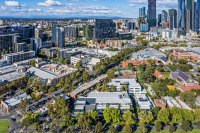
Higher education is currently Australia’s fourth largest export, worth almost $48 billion in 2023 – but a lack of student accommodation is putting this ‘golden goose’ at risk. Despite international students accounting for only 4% of private rentals, international student commencements have been capped at 270,000 to ease the private rental squeeze. Higher education institutions will need to provide extra student accommodation if they wish to increase their allocation.
Curtailing the growth of Australia’s higher education industry due to a lack of accommodation hurts everyone. The sector directly boosts employment, stimulates cities, educates our nation’s leaders, and builds valuable research and business relationships across the world. We need more students, not fewer – and the solution is rapidly rolling out more purpose-built student accommodation (PBSA).
Priming the pump to turbo-charge supply
In the 2024 Budget, the government allocated $2.1 million over 4 years to work with universities to ensure better provision of student housing; however, the current pipeline of a projected 7,770 new beds due to come online in the next 2 years is far lower than in comparable European cities. The Student Accommodation Council argues that it won’t make enough dent in the total need, projected at 84,000 new beds by 2026. Currently, Australia has only 1 PBSA bed for every 16 students.
This situation calls for a rapid shift in the current mindset and political discourse around student housing coupled with meaningful action on foreign investor taxes, planning schemes and approvals processes, so that these can enable rapid growth in accommodation supply. Reforms to residential tenancy laws that recognise the unique needs of this asset class will also help. Clarity and consistency of policy and regulations will be crucial for building the confidence of investors and unlocking the flow of capital.
Innovative partnerships, financing and contracting models
As in most things, the best solutions tend to come from collaboration and the will to try new approaches. We are seeing more partnerships emerging between private developers and universities where risks and rewards can be shared. For example, long-term land leases from universities to private developers are incentivising private development of new student accommodation on university land.
Developers are shielded from the very high upfront cost of acquiring land but can be confident of a long, stable flow of revenue, while universities are able to achieve their accommodation targets without needing to make significant capital outlays. With the cost of land acquisition being so high, there may be opportunities for universities to consider repurposing underused assets as student accommodation too.
We are seeing a number of procurement strategies, including ECI, which varies across geographies. However, we would always recommend assessing this on a project-by-project basis, taking into consideration competitive tension, risk allocation, and program, while keeping cost control at the forefront.
Optimising costs and value through design and operation
Achieving an optimal cost per bed will inevitably drive design – but there’s no pattern book for achieving the right balance between cost and quality or for nailing the right mix of private space, communal facilities, and opportunities for social interactions. What we do know is that students are all different and around 75% of the residents in PBSA are international, so accommodation needs and preferences will certainly be diverse.
Acceptable rents in the sector are fairly inelastic, so bringing the costs down will help more projects off the ground. However, configurations and quality will affect rental revenue and feasibility so there’s a fine balance to achieve.
Space efficiency should be considered early in the design cycle. Maximising the number of beds within the proposed space drives higher revenue and profit. Given the higher cost of bathrooms and kitchens, the most economical designs may be clusters with shared facilities rather than self-contained studios. Maximizing the efficiency of common spaces is crucial, as they add to construction costs but don’t always contribute proportionately to project feasibility.
Many accommodation developers are willing to pay an upfront premium to achieve a services design and system that will provide operational cost efficiencies in the future. A cost analysis of options should consider the capital costs as well as the lifecycle costs for the same systems, informing annual cost savings, net savings over the lifecycle, and payback periods.
Could new trends in efficient construction make a difference?
Modular construction, automation, BIM and digital twins are opening new opportunities to unlock construction efficiencies. Modular construction holds potential for reducing cost and timeframes through economies of scale and by mitigating the impacts of labour and skills shortages. However, we are yet to see enough completed modular PBSA projects throughout Australia to truly understand the extent of these savings.
Some developers are partnering with modular providers who can leverage lower labour and material costs offshore – but there are still a number of challenges to resolve, such as the risk allocation among client, contractor and module suppliers, the coordination of design between the on site and modular scope of works, and achieving compliance with Australian standards and regulations for modules constructed offshore.
Futureproofing Australia’s higher education industry
Getting student accommodation right is the key to unlocking the full potential of our higher education sector as an export industry. Overseas student sentiment is slow to turn around, and Australia can’t afford to undo the patient work of decades that has built our reputation as a premium education destination.
Our industry must pull together to quickly solve the accommodation challenge – accelerating supply of new PBSA that returns the right margins to investors while providing a comfortable and safe nest for students from near or far.
About the authors
David Thomas is a National Director at WT, based in Melbourne. David has diverse industry knowledge and specialist expertise in the residential sector (Student Accommodation, Social and Affordable housing, Build to Sell, Build to Rent) and delivery of major precinct and urban renewal projects. He brings nearly 30 years of experience across all major industry sectors. As part of the Victorian Senior Leadership team, David is responsible for strategic initiatives around clients and markets.
Simon Hensley is a National Director at WT, based in Sydney. Simon brings a wealth of expertise spanning mixed-use, commercial, residential, industrial, retail, independent living, aged-care, student accommodation, and hospitality developments from concept to completion. As part of WT’s National Leadership Team, Simon plays a key role driving strategic initiatives to enable business growth and create enhanced value for our clients.
Thomas Barry is an Associate at WT, based in Sydney. Having worked both in Australia and the United Kingdom, Thomas has vast experience from early feasibility cost planning through to final account agreement across various sectors including Student Accommodation, Residential, Aged Care, Industrial, Education and Commercial. Thomas’s communication style and accurate advice is well respected and appreciated by his clients enabling him to keep stakeholders informed at all times.






